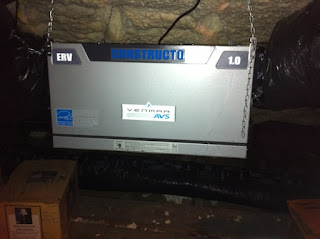In Part 5 below we explored why a new mantra of the building science community is: “Air tight, ventilate right.” Letting random air flow through a house is potentially bad for health (drawing in crawl space air, soil gases, etc.), and makes heating and air systems work harder. Air tightness reduces natural air exchange; oxygen that gets used by appliances and people does not get replaced as quickly as in a leaky building. That can result in trouble breathing and sleeping, and can present a real problem if there are combustion appliances in the home… unless you make clear and appropriate provisions for bringing fresh air into the house.
So, since we had begun to tighten up the house (with a sealed and insulated lid via spray foam on the roof deck), we needed to ensure we were getting an appropriate volume of healthy, fresh air into the house. There are a couple of ways to do this, with varying levels of control.
1. An occupancy sensor with timer for bath exhaust fans, sometimes paired with a passive inlet through the exterior wall
2. An Energy or Heat Recovery Ventilator (ERV or HRV)
There are merits to both, and cost implications. While option 1 is less expensive, it still brings in, through a simple filter, whatever air is outside. Since this is most critical in months we don’t have the windows open, that air could be 100º/95% humidity August air, or 20º/30% relative humidity February air. I chose an ERV, pictured here, because it not only filters the air that comes in, it captures or recovers some of the energy that is lost in the air exchange equation. An ERV takes air out of the house (typically from bathrooms, or maybe a utility or mudroom), and delivers fresh air from outside typically to bedrooms (because that is where we spend the most time in our homes). But, when it does this, it runs the two volumes of air past each other so that both sensible (air temperature) and latent (stored in moisture) heat can be transferred between the volumes of air. ERVs are typically about 60-70% efficient, meaning that if I have 68º/50% RH air inside, and its bringing in 18º/30% RH outside air (a 50º/20% spread), the 18º/30% air will be warmed to somewhere around 50º/42%RH before being delivered to my bedrooms. This eases the load on our heating and air system while bringing us the fresh air that helps us breath easier and sleep better. ERVs or HRVs are typically either installed in line with heating and air systems, or separate, with independent controls. We elected for the separate installation. The day it was installed I noticed an immediate difference the moment I walked in the door, a fresher feel, and diminished odors from the various things that can collect in a young family’s home!
A thorough discussion about ventilation with recovery ventilation systems can be found here:
http://www.greenbuildingadvisor.com/blogs/dept/musings/hrv-or-erv



No comments:
Post a Comment